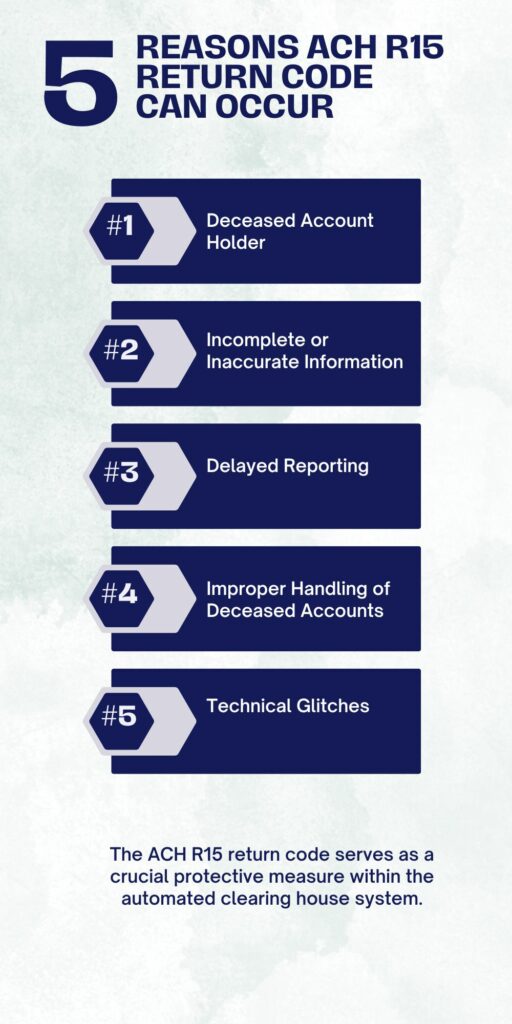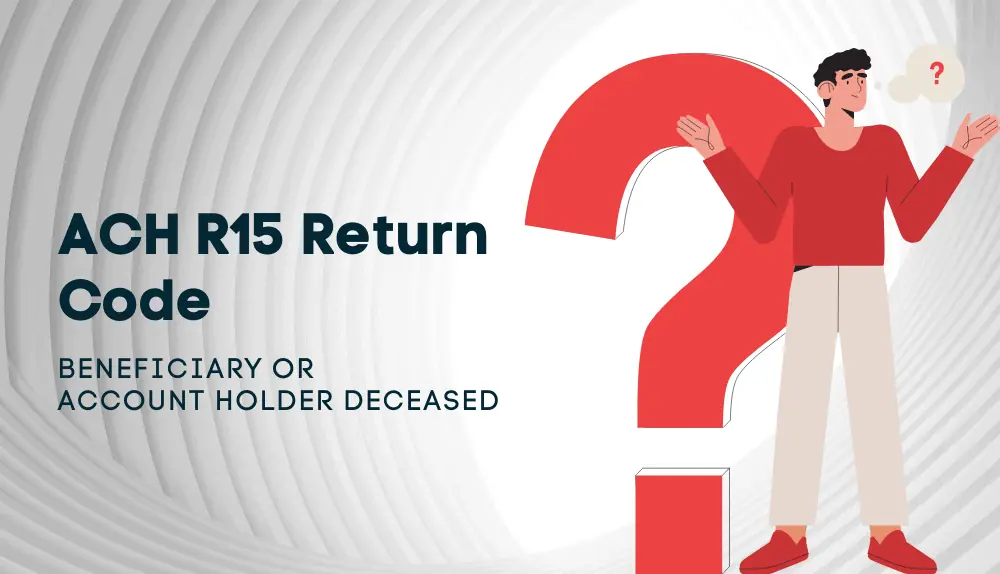When an account holder or a beneficiary is deceased the the code that is relevant is the R15 Return Code-Beneficiary or Account Holder Deceased . This article will explain the technical details about R15 return code and when it is used.
What Does ACH R15 Return Code Mean?
The ACH R15 return code signifies that a financial transaction could not be completed because the beneficiary or account holder has been reported as deceased. When this code is triggered, it means that the individual associated with the account has passed away, leading to the suspension of further processing of the transaction. This return code serves as a vital safeguard in the automated clearing house (ACH) system, preventing funds from being disbursed to an account that no longer has a valid holder or beneficiary.
The R15 return code not only ensures the integrity of the ACH network but also carries significant implications for the deceased person’s estate and their beneficiaries. It prompts financial institutions to take appropriate actions, such as freezing the account, resolving outstanding transactions, and directing any remaining funds to the appropriate estate or legal representatives. While the R15 code may evoke a sense of finality and sorrow, its importance lies in its ability to handle the sensitive matter of posthumous financial affairs with accuracy and respect.
Reasons ACH R15 Return Code Can Occur

The ACH R15 return code, “Beneficiary or Account Holder Deceased,” is triggered for specific situations when a financial transaction cannot be processed due to the reported death of the account holder or designated beneficiary. Several reasons may lead to the occurrence of the ACH R15 return code, each carrying significant implications for the involved parties. Let’s explore some of these reasons:
Deceased Account Holder
The most common reason for an ACH R15 return code is the passing of the account holder. When a financial institution receives notification or discovers that the account holder has died, they are required to freeze the account and halt any further transactions until the appropriate legal steps are taken by the deceased’s estate representatives.
Beneficiary’s Demise
In certain ACH transactions, a beneficiary is designated to receive funds. If the designated beneficiary is reported as deceased before the transaction is completed, the ACH R15 return code will be invoked, preventing the disbursement of funds to an ineligible party.
Incomplete or Inaccurate Information
Sometimes, incomplete or inaccurate information about the account holder or beneficiary can lead to an ACH R15 return code. If the financial institution cannot verify the recipient’s identity or their current status due to data discrepancies, they will decline the transaction.
Delayed Reporting
Financial institutions rely on timely information to ensure smooth transaction processing. If the report of the account holder’s or beneficiary’s death is delayed, it may result in an attempted transaction that triggers the ACH R15 return code.
Improper Handling of Deceased Accounts
In cases where the financial institution fails to update its records promptly upon being notified of the account holder’s death, there is a risk of erroneous transactions being initiated, leading to the activation of the ACH R15 return code.
Technical Glitches
In rare instances, technical glitches or system errors within the ACH network can result in false positives for the R15 return code, disrupting legitimate transactions.
The ACH R15 return code serves as a crucial protective measure within the automated clearing house system. By halting transactions associated with deceased account holders or beneficiaries, it ensures that funds are disbursed appropriately and safeguards against potential fraud or mishandling of posthumous financial affairs. Financial institutions play a crucial role in implementing the R15 code correctly and efficiently, respecting the sensitive nature of these transactions and supporting the families and estates of the deceased during a difficult time.
Steps to Fix ACH R15 Return Code

Fixing the ACH R15 return code requires prompt action and accurate handling to address the underlying issue effectively. Here are the steps to resolve the ACH R15 return code:
Confirm the Reason for the Return
Contact the financial institution to understand the exact reason for the ACH R15 return code. Verify whether it is due to the death of the account holder or beneficiary, incomplete information, delayed reporting, or any other specific cause.
Freeze the Account
If the ACH R15 return code is triggered due to the account holder’s death, freeze the account immediately to prevent any further transactions until the matter is resolved. This step ensures that no unauthorized or erroneous transactions occur.
Gather Necessary Documentation
Collect all the required documents, including death certificates, legal authorization, or any other documentation to confirm the status of the account holder or beneficiary. These documents will be essential to proceed with the resolution process.
Notify the Sending Party
If you are the recipient of the returned ACH transaction, promptly notify the sender about the situation and the reason for the return. Communicate any additional requirements or steps they need to take to reinitiate the transaction correctly.
Update Account Records
Ensure that the account holder’s status is appropriately updated in your records. Remove the deceased account holder from any active transactions or accounts and adjust beneficiary information accordingly.
Resolve Incomplete or Inaccurate Information
If the return was triggered due to incomplete or inaccurate information, verify the data provided and rectify any discrepancies. Ensure all necessary information, such as account numbers, names, and addresses, is complete and accurate.
Monitor Future Transactions
Implement measures to prevent similar issues from arising in the future. Regularly update account information, communicate with beneficiaries, and maintain accurate records to reduce the likelihood of encountering the ACH R15 return code.
Comply with Legal Requirements
If there are legal requirements for the resolution of the ACH R15 return code, such as presenting court orders or letters of administration, ensure that you comply with them promptly and accurately.
Educate Staff and Customers
Train your staff to handle sensitive situations like the ACH R15 return code with empathy and efficiency. Additionally, educate customers about the importance of keeping their account information up to date and the potential consequences of delayed reporting.
Review Internal Processes
Conduct an internal review of your organization’s processes and procedures to identify any areas for improvement that can help prevent ACH R15 return codes in the future.
By following these steps diligently, financial institutions can navigate the resolution process for the ACH R15 return code responsibly, safeguarding the interests of all parties involved while maintaining the integrity of the ACH system.
How Can Businesses Deal with ACH R15 Return Code
Dealing with the ACH R15 return code requires careful handling and adherence to proper procedures. For businesses, encountering this code can be challenging, but there are steps they can take to address it effectively. Here’s how businesses can deal with the ACH R15 return code:
Immediate Communication
As soon as a business receives the ACH R15 return code notification, they should reach out to their financial institution for clarification on the reason for the return. Open communication with the bank is crucial to understanding the specific issue and determining the necessary actions.
Verify Account Holder Status
Businesses should confirm the status of the account holder or beneficiary associated with the transaction. If the return is due to the death of the account holder, the business must respect the sensitivity of the matter and take appropriate measures.
Review Transaction Details
Examine the transaction details to identify any errors or discrepancies that may have triggered the ACH R15 return code. Ensure that all provided information, such as account numbers, names, and addresses, is accurate and up to date.
Update Account Records
If the return was caused by outdated information, the business should update its records promptly. This includes removing deceased account holders from active transactions and updating beneficiary information as necessary.
Coordinate with Customers/Vendors
Communicate with customers or vendors involved in the ACH transaction to inform them of the return and the reasons behind it. Work together to resolve any issues and, if needed, request updated and correct account information.
Implement Data Verification Procedures
Businesses should implement robust data verification procedures to ensure that all account-related information is accurate and up to date. Regularly verify and validate customer information to minimize the likelihood of encountering the ACH R15 return code in the future.
Resubmit Correct Transactions
If the return was due to an error on the business’s part, they should correct the mistake and resubmit the ACH transaction with accurate information. Ensure that the corrected transaction complies with all legal requirements.
Maintain Compliance with Regulations
Stay informed about the legal and regulatory requirements related to ACH transactions. Comply with all necessary documentation and reporting procedures as required by applicable laws.
Train Staff and Improve Processes
Train employees to handle ACH transactions effectively and educate them about the importance of maintaining accurate account information. Continuously review and improve internal processes to minimize the risk of encountering return codes in the future.
Monitor ACH Transactions
Regularly monitor ACH transactions to identify and address any potential issues proactively. Keep track of return codes to spot patterns and implement preventive measures.
Dealing with the ACH R15 return code requires sensitivity, accuracy, and a commitment to resolving the issue promptly. By taking these steps, businesses can minimize the impact of return codes and maintain a smooth and reliable ACH transaction process.
Final Words
The ACH R15 return code, “Beneficiary or Account Holder Deceased,” presents a poignant reminder of the human element intertwined within the world of financial transactions. Dealing with this code demands sensitivity, prompt action, and accurate handling to respect the dignity of those affected while upholding the integrity of the ACH system.
Financial institutions play a pivotal role in navigating the resolution process, freezing accounts, and communicating with customers and beneficiaries to ensure a responsible and empathetic approach. For businesses, encountering the ACH R15 return code necessitates vigilant data verification procedures, continuous process improvement, and compliance with legal requirements.
By promptly addressing the underlying issues and implementing preventive measures, businesses can minimize the likelihood of encountering such return codes in the future. Ultimately, understanding and effectively dealing with the ACH R15 return code not only protect financial systems but also demonstrate a commitment to supporting individuals and their families during challenging times, underscoring the significance of empathy and compassion in the realm of finance.
Frequently Asked Questions (FAQs)
Why did I receive an ACH R15 return code?
You may have received the ACH R15 return code if the account holder associated with the transaction has passed away or if there are inaccuracies or incomplete information in the provided account details.
What should I do if I encounter an ACH R15 return code?
If you encounter an ACH R15 return code, contact your financial institution to understand the reason for the return. If the code is due to the death of the account holder, respect the sensitivity of the matter, and ensure all necessary documentation is provided to resolve the issue.
Can the ACH R15 return code be reversed?
The ACH R15 return code can be resolved, and transactions can be corrected, but the return itself cannot be reversed. The code serves as an important safety measure to ensure that funds are handled appropriately in cases of deceased account holders or beneficiaries.
How can businesses avoid ACH R15 return codes?
Businesses can avoid ACH R15 return codes by implementing robust data verification procedures, regularly updating account records, and educating customers about the importance of providing accurate and up-to-date information.
What documentation is required to resolve the ACH R15 return code?
The required documentation may vary depending on the specific circumstances, but typically, the financial institution may request a death certificate or legal authorization confirming the status of the account holder or beneficiary.
Can I reinitiate a transaction after receiving the ACH R15 return code?
Yes, if the issue that triggered the return code has been resolved, you can reinitiate the transaction with accurate and updated information.
Is the ACH R15 return code common?
The ACH R15 return code is relatively common, especially when dealing with a large volume of ACH transactions. It serves as a crucial safeguard to ensure the proper handling of posthumous financial affairs.

